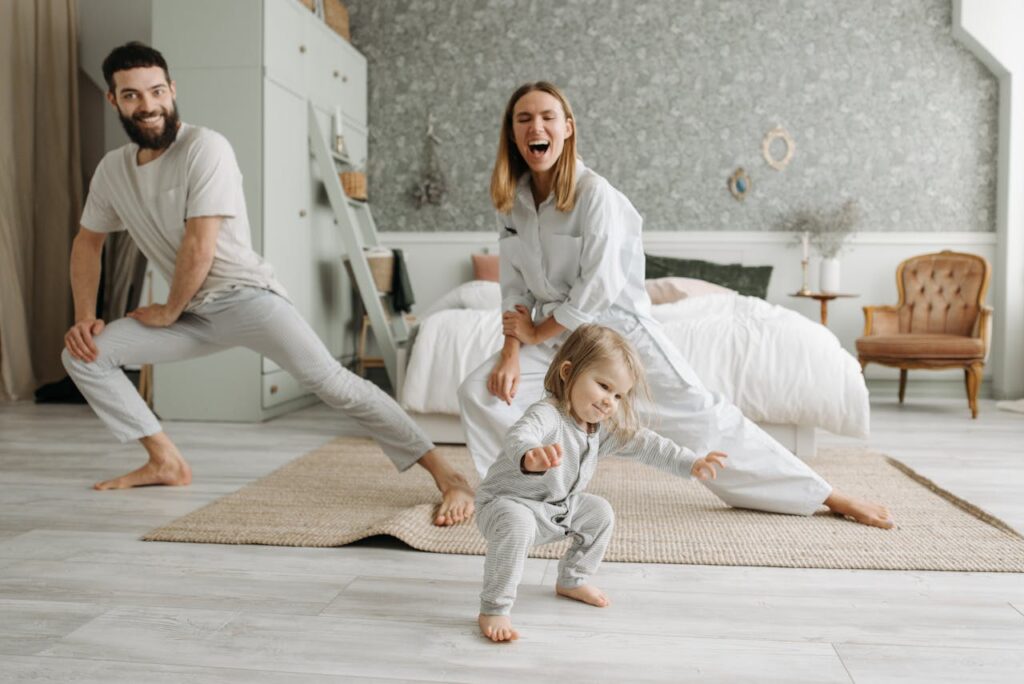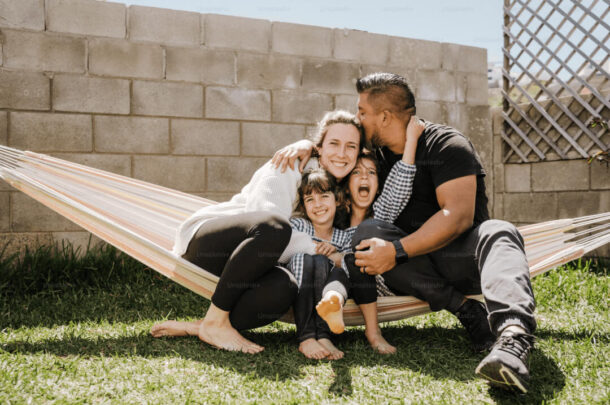Introduction
“Mooooom, my legs are tired!”
We’re exactly 47 seconds into our “fun family walk,” and my 6-year-old is already dramatically collapsing on the sidewalk like she’s crossed the Sahara Desert. Meanwhile, my teenager is trailing behind us, earbuds in, looking like I’ve sentenced her to hard labor.
This is not the Pinterest-perfect family fitness moment I imagined.
If you’ve ever tried to get your family moving and felt like you were herding cats through molasses, welcome to the club. The membership is huge, and we meet for coffee because we’re all too tired to exercise.
But here’s what I wish someone had told me three years ago when I was scrolling through Instagram, watching perfect families jog together in matching athletic wear while their golden retriever kept pace: Real family fitness is nothing like those carefully curated posts.
Real family fitness is bribing your preschooler with fruit snacks to complete an obstacle course. It’s your teenager grudgingly admitting that last night’s dance party was “actually kind of fun, I guess.” It’s discovering that your 8-year-old turns into a completely different human when they’re on a bike – confident, fearless, and finally not asking “Are we there yet?”
After three years of spectacular failures, surprising victories, and a lot of trial and error (emphasis on the error), I’ve figured out what actually works. And spoiler alert: it has way more to do with the right mindset and tools than it does with being the kind of parent who naturally loves 6 AM jogs.
The Reality Check Nobody Talks About
Let me tell you what the parenting blogs don’t mention: most of us are making this way harder than it needs to be.
We’re comparing our chaotic reality to other people’s highlight reels. We’re trying to force activities that worked for our neighbor’s family onto our completely different kids. We’re buying expensive equipment that looks amazing online but sits unused because nobody actually wants to use it.
The CDC says kids need 60 minutes of daily physical activity, and that number can feel like a mountain when your family’s idea of movement is walking from the couch to the kitchen. But here’s the secret that changed everything for us: it doesn’t have to be perfect, coordinated, or even look like “exercise.”
My friend Lisa figured this out when she stopped trying to get her three kids to enjoy the same activity. Her 4-year-old loves anything that involves jumping. Her 9-year-old is obsessed with timing herself doing everything. Her 13-year-old will participate in family activities only if they don’t feel too “kiddy.”
So what did Lisa do? She got smart about it.
Instead of forcing everyone into the same mold, she invested in a few key pieces of equipment that could adapt to different interests and energy levels. The KidiStar DJ Mixer became the soundtrack for the 4-year-old’s jumping sessions, the 9-year-old’s timed fitness challenges, and yes, even the 13-year-old’s “accidental” dance parties when she thought no one was looking.
“The game-changer wasn’t finding the perfect activity,” Lisa told me. “It was realizing that my kids needed different things, and finding tools that could grow with all of them.”
The Age-by-Age Reality Guide (What Actually Works, Not What Should Work)
Ages 1-3: The Tiny Tornadoes
The Reality: Toddlers have two speeds: sleeping and chaos. They don’t understand the concept of “gentle” or “careful,” and their attention span for any single activity is roughly equivalent to a goldfish.
What Doesn’t Work: Structured activities, complicated rules, or anything that requires them to sit still for more than 30 seconds.
What Actually Works:
Controlled Chaos Zones: Remember when you used to have nice furniture? Those days are over anyway, so lean into it. The Little Tikes Activity Gym is basically a jungle gym for your living room, and it’s sturdy enough to survive whatever your tiny human throws at it (literally).
My sister was skeptical about putting what looked like playground equipment in her house, but after three months of Minnesota winter with a 2-year-old bouncing off the walls, she caved. “Best decision ever,” she texted me. “Emma climbs on this thing for hours, and I don’t have to worry about her destroying the actual furniture.”
The Magic of Safe Balls: Not all balls are created equal when you have a toddler. Regular balls are either too hard (goodbye, lamp) or too bouncy (hello, ceiling fan incident). The Melissa & Doug Plush Ball is soft enough for indoor use but structured enough that kids can actually catch and throw it successfully.
Success breeds more interest. When kids can actually do the thing they’re trying to do, they want to keep doing it.
Dance Parties That Don’t Require Your Phone: Here’s the thing about trying to play music from your phone for toddler dance parties: your phone will inevitably ring, or you’ll get a text, or the music will stop because of some random notification. The KidiStar DJ Mixer solved this problem completely.
It’s not just a speaker – it’s an experience that makes kids feel like they’re controlling the party. My friend’s 3-year-old calls it “my music maker” and asks for dance parties every single day. And because it’s designed for kids, it’s loud enough to get everyone moving but not so loud that the neighbors complain.
The Real Talk: Your house will be messier. Your living room will look like a soft play area. Your Instagram aesthetic will suffer. But your toddler will burn energy, develop gross motor skills, and actually tire themselves out enough to nap. Pick your battles.
Ages 4-7: The Rule-Followers Who Change Rules Constantly
The Reality: This age group loves games with rules, but they also love changing those rules mid-game. They have strong opinions about fairness, they want to win (but they also want everyone else to have fun), and they can sustain interest in activities for longer periods – if those activities are interesting enough.
What Doesn’t Work: Overly competitive activities, anything too advanced, or activities where they’re likely to fail repeatedly.
What Actually Works:
Bikes That Actually Teach Balance: Teaching kids to ride bikes can be one of those parenting moments that either becomes a treasured memory or a screaming match in the driveway. The Schwinn Balance Bike completely changes this equation.
Instead of training wheels that actually make learning harder, balance bikes teach the most important skill first. Kids learn to balance and steer without the complication of pedaling. My neighbor’s daughter went from a balance bike to a regular bike in literally one afternoon – no tears, no drama, no parent running behind holding onto the seat.
“I was dreading teaching her to ride,” her mom told me. “But the balance bike made it so natural. She just hopped on a regular bike and rode away like she’d been doing it for years.”
Backyard Adventure Central: The Step2 Playhouse might look like just a playhouse, but in our experience, it becomes the center of about 90% of outdoor activities. It’s the base camp for hide-and-seek, the castle in elaborate princess games, the finish line for races, and the secret hideout for spy missions.
The quality difference between this and cheaper playhouses is significant. It survives weather, multiple kids playing roughly, and years of use. Plus, it’s big enough that kids don’t outgrow it quickly.
Skills They Can Actually Master: The Green Toys Jump Rope is perfect for this age because it’s sized correctly and the weight is right for developing coordination. Kids can actually succeed at jumping rope, which makes them want to practice more, which makes them better at it.
I watched my friend’s 5-year-old go from barely managing one jump to proudly showing off her “tricks” over the course of a few weeks. The confidence boost was incredible.
The Real Talk: This age will turn everything into a competition, including who can put their shoes on the fastest. Use this to your advantage. Time challenges, friendly races, and achievement stickers work like magic.
Ages 8-12: The Social Scientists Who Judge Everything
The Reality: School-age kids are developing their own sense of what’s “cool” and what’s “babyish.” They care about what their friends think. They want activities that feel age-appropriate, and they’re starting to compare themselves to others in ways that can either motivate or discourage them.
What Doesn’t Work: Anything that feels too much like “little kid” activities, overly structured fitness routines, or activities where they feel like they’re not good enough compared to others.
What Actually Works:
Sports Without the Pressure: The Wilson Soccer Ball lives in our garage and gets used constantly – not for formal soccer practice, but for backyard games, driveway challenges, and impromptu matches when friends come over. It’s regulation size, so it feels “real,” but there’s no pressure to perform at any particular level.
The key is having quality equipment that doesn’t break after a few uses. Cheap balls deflate, lose their shape, or pop at the worst moments. This one lasts, which means it actually gets used.
Adventure Equipment That Makes Them Feel Capable: The Osprey Kids’ Backpack transformed hiking for our family. Instead of me carrying everything and the kids feeling like they were just along for the ride, everyone had their own pack with their own supplies.
Kids this age love feeling responsible and capable. Having their own real hiking gear (not toy gear) makes them feel like legitimate adventurers. Plus, when they’re carrying their own water and snacks, they’re more invested in the success of the hike.
Skills That Show Progress: Basketball is perfect for this age because improvement is visible and measurable. The Spalding Basketball is worth the investment because it has the right weight and bounce for developing proper shooting form.
My friend’s 10-year-old went from barely being able to hit the backboard to making consistent free throws over one summer. Having quality equipment helped him develop real skills instead of just fooling around.
The Real Talk: This is the age where kids start comparing themselves to others more intensely. Focus on personal improvement and effort over natural talent or competition with others.
Ages 13-18: The Eye-Rollers Who Actually Care More Than They Let On
The Reality: Teenagers want independence, they’re incredibly busy, they care deeply about what their friends think, and they often resist anything that feels like forced family time. But they also want to feel strong, capable, and healthy – they just want to get there on their own terms.
What Doesn’t Work: Anything that feels babyish, forced family activities that don’t respect their need for independence, or activities that make them feel self-conscious about their abilities.
What Actually Works:
Technology That Meets Them Where They Are: The Fitbit Versa 4 works because it makes fitness feel modern and personal. It’s not about family exercise time – it’s about their personal goals, their sleep patterns, their progress.
My friend’s 15-year-old daughter was completely uninterested in family walks until she got a fitness tracker. Suddenly, she was suggesting walks to hit her step goals. She started taking the stairs instead of the elevator. She wasn’t doing it for family bonding – she was doing it for herself, which is exactly what a 15-year-old should be doing.
Independence-Supporting Equipment: A Gaiam Yoga Mat gives teens their own space for whatever kind of movement they want to explore. Whether it’s following YouTube yoga videos, doing strength training exercises, or just stretching while watching Netflix, having their own quality mat makes it feel personal and private.
The key is that it’s theirs. Not family equipment, not something they have to share or use on your schedule.
Activities That Connect to Their World: The Razor Skateboard opens up a completely different activity ecosystem. Skateboarding has its own culture, its own community, and its own progression of skills that teens can master independently.
One of my neighbor’s sons went from being completely sedentary to spending hours at the skate park, making new friends, and even helping younger kids learn basics. It wasn’t family fitness, but it was fitness, and it happened because we supported his interest instead of trying to force our vision of what his exercise should look like.
The Real Talk: Sometimes the best family fitness strategy with teenagers is to support their individual fitness interests and occasionally get invited to participate, rather than trying to make them participate in your family fitness vision.
The Equipment That Actually Gets Used (And Why Most Don’t)
Here’s what I wish someone had told me before I spent hundreds of dollars on equipment that’s now gathering dust in the garage: most fitness equipment fails because it only serves one purpose for one age group for a short period of time.
The stuff that works long-term is versatile, grows with your kids, and serves multiple purposes.
The Hall of Fame: Equipment That Earns Its Keep
The Music Game-Changer: We’ve had our KidiStar DJ Mixer for two years now, and it’s been used by every member of our family. It started as a toddler dance party machine, evolved into background music for family game nights, and now my teenager uses it when her friends come over.
It’s not just a speaker – it’s an experience that makes everyone feel like they’re controlling the party. And because it’s built for kids, it survives being dropped, juice spills, and enthusiastic button-pushing.
The Timer That Makes Everything a Game: The Time Timer doesn’t look like fitness equipment, but it’s become essential for all our activities. Everything becomes more engaging when there’s a visual countdown. “How many jumping jacks can you do in two minutes?” “Let’s see if we can clean up the backyard obstacle course before the timer goes off!” “Dance party until the red disappears!”
Kids respond to visual time limits in ways that verbal time limits don’t achieve. It makes activities feel finite and manageable.
The Ball That Does Everything: The Franklin Sports Ball set was one of our smartest purchases because it removed the barrier of “what sport do we want to play?” Instead, we have options. Football, soccer, basketball, dodgeball – whatever matches the mood or the available space.
Having variety in one purchase meant we could discover what our kids were actually interested in without buying specialized equipment for every possible sport.
The Hall of Shame: Equipment That Seemed Like a Great Idea
Expensive Single-Purpose Items: That fancy balance board that was supposed to improve core strength? Used it three times. The resistance bands for family strength training? Still in the package. The elaborate swing set that took a weekend to assemble? They played on it for two weeks.
Anything That Requires Perfect Conditions: Equipment that only works in specific weather, at specific times, or with specific preparation rarely gets used. Real life is messy and spontaneous.
Items That Don’t Match Your Family’s Actual Interests: Just because something works for other families doesn’t mean it will work for yours. Your kids’ personalities and interests matter more than expert recommendations.
The Stories That Changed My Mind About Family Fitness
The Martinez Family: When Everything Clicked
Maria thought she was failing at family fitness. Her 8-year-old Diego was obsessed with superhero movies but had zero interest in traditional sports. Her 14-year-old Sofia loved music but thought exercise was boring.
“I kept trying to force them into activities that worked for other families,” Maria told me. “Soccer for Diego because boys are supposed to like soccer. Jogging for Sofia because she needed cardio. Everyone was miserable, including me.”
The breakthrough came when Maria stopped trying to impose activities and started observing what her kids were already interested in. Diego was always setting up elaborate obstacle courses with couch cushions and pretending to be different superheroes. Sofia was always dancing while doing chores, but she’d stop if anyone noticed.
Maria invested in the Little Tikes Activity Gym for Diego’s superhero training courses and the KidiStar DJ Mixer for Sofia’s private dance sessions (that gradually became less private as the music drew everyone in).
“The equipment made the difference because it supported what they already wanted to do, instead of trying to convince them to want something different,” Maria explained. “Now Diego spends hours creating new ‘training courses’ and Sofia actually DJs our family dance parties. They don’t even realize they’re exercising.”
Six months later, the family added the Schwinn Balance Bike for neighborhood adventures and Osprey Kids’ Backpacks for weekend hiking. But it all started with meeting her kids where they already were.
The Thompson Family: The Teenager Turnaround
Sarah was convinced her 15-year-old son Jake was going to spend his entire adolescence on the couch playing video games. Every suggestion for family activities was met with eye rolls or flat-out refusal.
“I was getting desperate,” Sarah admitted. “I tried bribing him, arguing with him, taking away privileges. Nothing worked, and we were both frustrated.”
The shift happened when Sarah stopped making it about family time and started making it about Jake’s personal goals. He’d mentioned wanting to get in better shape for his part-time job (which involved a lot of walking), and he was always complaining about being tired.
Instead of suggesting family hikes, Sarah got Jake the Fitbit Versa 4 and framed it as a tool for his personal goals. “I told him it would help him track his sleep and energy levels, not that it would get him exercising,” Sarah said.
Within a week, Jake was asking to walk to the store instead of getting a ride because he wanted to hit his step goals. A month later, he was suggesting family walks because he’d noticed the whole family could use more steps.
“The key was making it his choice and his goals, not mine,” Sarah reflected. “Once he felt ownership over his fitness, he actually wanted the family involved.”
The Wilson Family: Seasonal Success
For Amy Wilson and her twins (age 7), the challenge was maintaining momentum year-round. “We’d have great active summers, then completely sedentary winters,” Amy said.
The solution was building a rotation of seasonal equipment that kept things fresh:
Winter: Gaiam Yoga Mats for living room obstacle courses and YouTube yoga videos Spring: Gardening Tool Set for Kids for yard projects and Green Toys Jump Rope for outdoor challenges Summer: Wilson Soccer Ball and sprinkler games Fall: Osprey Kids’ Backpacks for hiking and nature collecting
“Having the right equipment for each season meant we always had something appealing available,” Amy explained. “The kids started looking forward to seasonal transitions because it meant new activity options.”
The Mindset Shift That Changes Everything
Here’s the thing that took me way too long to figure out: family fitness isn’t about creating mini-athletes. It’s about creating humans who see movement as a normal, enjoyable part of life.
That looks different for every family, and it definitely doesn’t look like those Instagram posts with everyone in matching workout clothes smiling at 6 AM.
For us, family fitness looks like:
- Dance parties in the kitchen while dinner cooks
- Bike rides to the ice cream shop (priorities!)
- Backyard obstacle courses that get increasingly ridiculous
- Hiking adventures where we spend more time looking at interesting rocks than actually hiking
- Basketball games where the rules change every five minutes
It’s not perfect, it’s not always Pinterest-worthy, and some days it doesn’t happen at all. But it’s ours, and it works for us.
The Three Questions That Matter
When you’re trying to figure out what will work for your family, ask these questions:
- What do my kids already enjoy doing? (Build on existing interests instead of creating new ones)
- What time of day is everyone most energetic and least stressed? (Don’t fight your family’s natural rhythms)
- What would make this easier, not harder? (Choose convenience and simplicity over perfection)
Your Real-World Action Plan (No Perfection Required)
Week 1: Observe and Listen
Don’t buy anything yet. Just pay attention to:
- When your kids naturally move and seem energetic
- What types of movement do they gravitate toward (dancing, climbing, running, throwing things)
- What time of day everyone is in the best mood
- What activities make them lose track of time
Week 2: Start With One Thing
Based on what you observed, pick ONE piece of equipment that supports something your family already shows interest in:
- If there’s already dancing happening: KidiStar DJ Mixer
- If there’s climbing and jumping: Little Tikes Activity Gym
- If there are ball games: Franklin Sports Ball set
- If there’s interest in timing and challenges: Time Timer
- If individual activities work better: Green Toys Jump Rope or Gaiam Yoga Mat
Week 3: Make It Stupidly Easy
Remove every barrier you can think of:
- Keep equipment somewhere easily accessible
- Don’t require everyone to participate every time
- Start with 5-10 minute activities
- Celebrate participation, not performance
- Have backup indoor options ready
Week 4: Follow Your Family’s Lead
Pay attention to what’s working and what isn’t:
- Which activities happen naturally?
- What equipment gets used without prompting?
- When do people seem most engaged?
- What makes everyone groan and complain?
Adjust based on what you learn. There’s no shame in changing course.
The Long Game: What Success Actually Looks Like
Three years into this family fitness journey here’s what success looks like in our house:
- My teenager voluntarily suggests walks because she likes how she feels afterward
- My 8-year-old sets up obstacle courses without being asked
- Family dance parties happen spontaneously when a good song comes on
- Everyone knows where the sports equipment is and feels comfortable using it
- We have backup indoor activities for bad weather days
- Exercise isn’t a chore that requires negotiation
But here’s what success doesn’t look like:
- Perfect participation from everyone every day
- Instagram-worthy coordination and enthusiasm
- Consistent timing or duration
- Everyone loving all the same activities
- Zero complaining or resistance
The goal was never perfection. The goal was creating a family culture where movement feels normal and enjoyable, where everyone has activities they genuinely like, and where being active together creates good memories instead of stress.
The Bottom Line: It’s Messier and Better Than You Think
Family fitness is not going to look like what you see on social media or in parenting magazines. It’s going to look like your family – messy, imperfect, evolving, and real.
Some days everyone will be enthusiastic. Other days you’ll bribe your kids with screen time to get through a 10-minute activity. Some activities will become beloved family traditions. Others will be spectacular failures that become funny stories later.
The equipment that works will be the stuff that fits your actual life, not your ideal life. The activities that stick will be the ones that feel natural and enjoyable, not the ones that check all the “healthy family” boxes.
And that’s not just okay – it’s perfect. Because the goal isn’t to win any parenting awards. The goal is to raise kids who feel comfortable in their bodies, who know that movement can be fun, and who have good memories of being active with their families.
Start where you are. Use what appeals to your actual kids, not the kids you think you should have. Invest in equipment that supports their real interests. Be willing to change course when something isn’t working.
And remember: the family that plays together, stays together – even if that play involves a lot more negotiation, bribery, and chaos than anyone posts about online.
Your fitness journey starts now, exactly as you are, with the family you have. And that’s exactly perfect.
What’s your biggest family fitness challenge right now? Share with the ParentMosaic community in the comments – chances are, other parents are dealing with the exact same thing!




